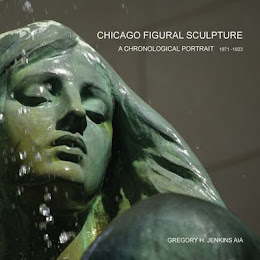Chicago had been very very good to Henry Hering. Assistant to Philip Martiny on the Fine Arts Building at the Columbian Exposition. Then a Commission in his own right to replace that work with permanant stone in 1919. Followed by The Field Museum's commission for Caryatids, statuary and Allegorical Panels. The Benjamin Franklin Ferguson Fund selection for two bridgetowers on Michigan Avenue must have seemed too good to be true. And now, Samuel Insull and the Opera Block.
.
Hering's work is usually solid. Staid. But here, for the first time, there is a sense of softness. He flirts briefly with Deco. This was his last commission in the area until W. P. Gleason brought him back in 1931 to Gary Indiana. For one last great adventure: Father Marquette striding (in full regalia) from the source of the Grand Calument River.






















































Talking about Michigan Avenue bridge towers, I guess, Henry Hering got a better deal.
ReplyDeleteHe got the south side, which always has the sunlight. Fraser, I guess, had a more challenging location, with less light.
And Hering got to elucidate more talked about events in the history of Chicago - Fort Dearborn massacre and the Great Chicago Fire.. Any tourist would know about the Chicago Fire much more than other events.
I'm guessing Defense would also be the most photographed amongst all four, because of it's location and two stunning buildings in the background.. with Wrigley Tower and Tribune Tower. Who wouldn't love those bldgs